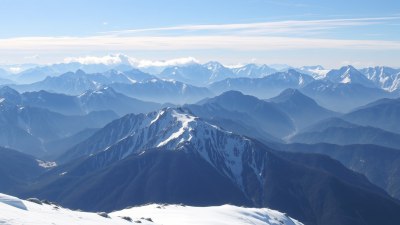The Role of Albedo in Weather and Climate
Explore how albedo influences weather patterns and climate by affecting Earth's energy balance and temperature.

Albedo represents one of the fundamental concepts in understanding the Earth's energy balance, playing a crucial role in shaping weather and climate. At its core, albedo refers to the fraction of solar radiation that is reflected by a surface without being absorbed. This simple yet powerful property influences how much sunlight is retained by the Earth system, thereby affecting surface temperatures, atmospheric circulation, and even broader climate patterns.
To fully grasp the significance of albedo in weather and climate dynamics, it's essential to delve into its physical basis, the variability across different surfaces, and how changes in albedo can lead to feedback mechanisms within the climate system. Moreover, recent changes in land use, polar ice cover, and even urban development have altered Earth's albedo, highlighting its critical importance for current and future climate predictions.
Defining Albedo: Physical Meaning and Measurement
Albedo is expressed as a dimensionless value ranging from 0 to 1, where 0 indicates complete absorption of incident solar radiation (no reflection), and 1 corresponds to perfect reflection (no absorption). Earth's average albedo is approximately 0.3, meaning around 30% of incoming solar radiation is reflected back to space, while the remaining 70% is absorbed by the atmosphere, oceans, and land surfaces.
This balance is measured using satellites equipped with radiometers that detect solar radiation reflected off different surfaces. Additionally, ground-based measurements can precisely determine albedo values in localized areas. The albedo varies significantly depending on surface characteristics such as color, texture, moisture content, and angle of incidence of sunlight.
Albedo of Different Earth Surfaces
Various surfaces on Earth exhibit distinct albedo values. Snow and ice, for example, possess some of the highest albedo values, often exceeding 0.8 to 0.9 because their bright, reflective surfaces send most sunlight back towards space. Conversely, dense forests and ocean waters absorb more sunlight due to their dark surfaces, displaying albedo values around 0.1 to 0.15.
Deserts and sandy areas typically reflect between 0.3 and 0.4 of incoming solar radiation because their light-colored surfaces have intermediate reflectivity. Urban areas, with concrete and asphalt, tend to have relatively low albedo values, often less than 0.2. Variations in albedo over both spatial and seasonal scales contribute to complex patterns in heat absorption and, consequently, atmospheric circulation.
The Role of Albedo in Earth's Energy Balance
Earth's climate system hinges on a delicate balance between the energy it receives from the sun and the energy it radiates back into space. Albedo plays a pivotal role in this balance by modulating how much solar energy is reflected immediately after entry into the atmospheric system. Higher albedo leads to reduced solar energy absorption, promoting cooler surface temperatures, while lower albedo means more energy is absorbed, warming the surface.
As part of this system, Earth's surface albedo interacts with atmospheric albedo, which stems from clouds and atmospheric particles. Clouds tend to increase Earth’s overall albedo because they reflect sunlight, but they also trap outgoing infrared radiation, creating a complicated effect on temperature regulation. Nonetheless, surface albedo remains one of the primary determinants of how solar radiation is partitioned at the planetary level.
Albedo Feedback Mechanisms in Climate
One of the most significant aspects of albedo in the climate system is its involvement in feedback loops that either amplify or dampen climate changes. The ice-albedo feedback is a classic example: as global temperatures rise, ice and snow cover diminish, lowering the Earth's surface albedo. This reduction allows more solar energy to be absorbed, further accelerating warming and ice melt in a reinforcing cycle.
This positive feedback mechanism is particularly potent in polar regions, where ice loss is more rapid compared to other locations. It contributes to polar amplification, a phenomenon where polar temperatures increase faster than the global average. Moreover, similar feedbacks occur in other regions as altered vegetation and soil moisture change surface albedo, thus influencing local and regional climates.
Impact of Human Activities on Albedo
Human activities have caused measurable shifts in Earth's surface albedo. Deforestation reduces the reflective canopy provided by forests and often increases the reflectivity when replaced by agricultural land or bare soil, depending on the region and land management. Urbanization creates impervious surfaces such as roads and roofs, which typically lower the surface albedo and increase heat absorption, contributing to urban heat islands.
Additionally, the loss of ice in Arctic and Antarctic regions, driven by anthropogenic global warming, has dramatically decreased regional albedo, augmenting warming trends. Efforts to mitigate climate change are increasingly considering how land management and urban planning can modify albedo properties to achieve cooling effects, such as the use of reflective building materials and vegetation cover.
Role of Albedo in Weather Patterns
Albedo influences weather by affecting surface temperatures, which in turn govern air pressure differences and wind patterns. For instance, surfaces with high albedo remain cooler during daylight hours, potentially stabilizing local atmospheric conditions and reducing convection, thus influencing cloud formation and precipitation patterns.
In contrast, darker surfaces absorb more heat, leading to increased surface temperatures that enhance convection and can stimulate cloud development, thunderstorms, and localized precipitation events. The contrast in albedo between urban and surrounding rural areas often leads to modified local weather, including alterations in wind flows and rain distribution.
Albedo Variation and Seasonal Climate Effects
Seasonal changes in albedo, particularly in regions with snow cover, can induce substantial shifts in climate conditions. During winter, snow accumulation leads to high surface albedo, reflecting much of the sunlight and maintaining cooler temperatures. As snow melts in spring, the albedo decreases sharply, resulting in greater absorption of solar energy and rapid warming, often contributing to seasonal temperature swings.
These seasonal albedo dynamics affect atmospheric circulation by altering temperature gradients between land and oceans and between polar and equatorial regions. The timing and extent of snowmelt, therefore, have significant implications for weather patterns, growing seasons, and water resource availability in many parts of the world.
Measurement Techniques and Modeling of Albedo
Understanding albedo's role in climate requires accurate measurement and modeling. Remote sensing technologies provide detailed spatial data about surface reflectivity using instruments aboard satellites like MODIS (Moderate Resolution Imaging Spectroradiometer) and CERES (Clouds and the Earth’s Radiant Energy System). These data enable scientists to monitor changes in albedo over time and across regions globally.
Climate models incorporate albedo as a critical parameter to simulate Earth's energy balance and forecast future climates. These models must carefully represent surface characteristics, snow and ice dynamics, cloud processes, and land-use changes to accurately predict albedo variations and their climatic impacts. Improved model resolution and data inputs continue to enhance predictions related to albedo-driven climate feedbacks.
Albedo Modification as a Geoengineering Proposal
Given albedo's influence on climate, some geoengineering proposals suggest artificially increasing Earth's albedo to reflect more sunlight and counteract global warming. Techniques such as brightening clouds or covering deserts with reflective materials have been hypothesized to increase planetary albedo. These strategies aim to induce cooling effects by reducing solar energy absorption.
However, the practical implementation of albedo modification raises significant scientific, environmental, and ethical concerns. Potential unintended consequences include disruptions to regional weather patterns, impacts on ecosystems, and geopolitical issues related to controlling climate engineering technologies. Research continues to evaluate if albedo modification could serve as a supplementary tool alongside emissions reductions to combat climate change.
The Connection Between Land Use and Albedo Changes
Changes in land use, such as agriculture expansion, deforestation, or urban sprawl, directly alter surface albedo with consequences for regional and local climates. For example, converting forested areas into cropland often increases surface albedo, which might cool the local environment but also reduce carbon sequestration capacity. Conversely, greening deserts or implementing afforestation lowers albedo but enhances carbon uptake.
Understanding these complex trade-offs is vital for sustainable land management policies that balance climate mitigation objectives, biodiversity conservation, and food security. Integrating albedo considerations into land-use planning can optimize climate benefits while minimizing adverse impacts on weather and hydrological cycles.
Polar Regions: Albedo and Climate Sensitivity
The polar regions serve as critical zones illustrating how albedo impacts climate sensitivity. The presence of sea ice in the Arctic and ice sheets in Antarctica creates high albedo surfaces that moderate temperatures by reflecting sunlight. As warming leads to ice retreat, areas of darker ocean or land absorb more solar radiation, accelerating regional warming through positive feedbacks.
Besides influencing temperature, changes in polar albedo affect global ocean circulation, atmospheric jet streams, and weather extremes at lower latitudes. These interconnections make polar albedo dynamics a focus of intensive scientific research and monitoring, pivotal for predicting global climate trajectories.
Albedo Influence on Earth's Water Cycle
The interplay between albedo and the water cycle is significant. Surface temperatures influenced by albedo variations affect evaporation rates, cloud formation, and precipitation patterns. Higher albedo areas with cooler temperatures typically produce less evaporation, influencing atmospheric moisture content and rainfall distribution.
Conversely, lower albedo surfaces encourage higher evaporation, potentially increasing local and regional precipitation but also possibly contributing to drought conditions elsewhere through atmospheric circulation shifts. These interactions highlight the complexity of Earth's climate system and the multifaceted role albedo plays beyond merely reflecting sunlight.
Albedo's Role in Climate Change Detection and Attribution
Albedo is a key variable for detecting and attributing climate change. Monitoring changes in surface reflectivity supports understanding of whether observed temperature trends relate to natural variability, human activities, or a combination of both. For instance, reductions in snow cover and glacier extents are directly measured through albedo shifts, providing evidence for warming-induced changes.
Improved observations linking albedo changes with radiative forcing help attribute specific climate phenomena to driving factors. This knowledge is essential for developing mitigation and adaptation strategies, as well as informing policymakers and the public about the mechanisms behind observed climate changes.
Innovations in Albedo Research and Future Directions
Advancements in sensor technologies, data analytics, and climate modeling are opening new frontiers in albedo research. High-resolution satellite data now capture finer temporal and spatial albedo variations, enabling more precise studies of diurnal and seasonal cycles. Integrating machine learning techniques has improved identification of subtle albedo changes related to vegetation shifts, urban development, and snow dynamics.
Future research priorities include better understanding albedo variability under extreme weather events, the coupling between albedo and biogeochemical cycles, and the systemic impacts of human interventions. Additionally, exploring scalable interventions for albedo management in a responsible and equitable manner represents an important challenge for the scientific community.
In sum, albedo serves as a vital intermediary in Earth's climate system, controlling how solar energy is partitioned and influencing atmospheric, oceanic, and land processes. Its variability underpins fundamental climate feedbacks, modulates weather patterns, and serves as a barometer for climate change. Grasping the nuances of albedo and its interactions is indispensable for advancing climate science and crafting effective environmental policy.











